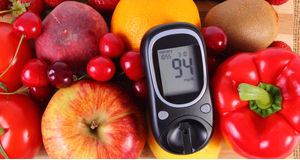Diabetes Management
What is the Difference between Diabetes Insipidus and Diabetes Mellitus?
2 min read
By Apollo 24|7, Published on - 12 September 2023, Updated on - 14 September 2023
Share this article
0
0 like
_0.jpg?tr=q-80)
Unlike popular belief, diabetes insipidus is not just another type of diabetes. Other than having the same first name and some of the common symptoms, diabetes insipidus, and diabetes mellitus are completely different from each other in terms of causes, effects on the body, and treatments.
Diabetes Mellitus
Diabetes mellitus is a chronic disease that affects the body's ability to produce or use insulin. There are several subtypes of diabetes mellitus, with type 1 and type 2 being the most common.
Type 1 Diabetes: It is an autoimmune disease where the immune system mistakenly attacks and destroys insulin-producing beta cells in the pancreas. As a result, people with type 1 diabetes require insulin injections or an insulin pump to regulate their blood sugar levels.
Type 2 Diabetes: This is a metabolic disorder characterized by insulin resistance, where the body's cells don't respond effectively to insulin. It is often associated with lifestyle factors like obesity and physical inactivity, although genetics also play a role. Type 2 diabetes can typically be managed with lifestyle changes, oral medications, and in some cases, insulin.
Diabetes Insipidus
Diabetes insipidus, on the other hand, is a rare condition that has nothing to do with blood sugar levels. It affects the body's ability to regulate water balance, leading to excessive thirst and urination. There are several types of diabetes insipidus, but the most common is called central diabetes insipidus, which is caused by a deficiency of vasopressin, a hormone that helps the kidneys reabsorb water.
Impact, Causes & Treatment
|
Diabetes Mellitus |
Diabetes Insipidus |
|
|
Impact on the body |
Affects blood sugar regulation |
Affects water balance |
|
Cause |
Body’s inability to produce or utilise insulin |
Issue with making or using vasopressin (or antidiuretic hormone) |
|
Treatment |
medication, diet, and lifestyle changes |
Medications that mimic the action of vasopressin |
Conclusion
Understanding these differences is crucial for accurate diagnosis and effective management. If you or someone you know is experiencing symptoms related to diabetes, it's essential to consult a healthcare professional for a proper evaluation and personalized treatment plan.
Diabetes Management
Consult Top Diabetologists
View AllLeave Comment
Recommended for you
.jpg?tr=q-80)
Diabetes Management
Spices for Diabetes: Flavorful Blood Sugar Control
Spices are not just flavour enhancers but can also aid in managing diabetes. Including spices like cinnamon, ginger, and fenugreek can help regulate your blood sugar levels. However, consulting a doctor before making any dietary changes is imperative. Incorporating lifestyle modifications along with a balanced diet can go a long way in managing diabetes, so consider enrolling in the Apollo Super programme and learn to manage diabetes holistically.

Diabetes Management
Sugarcane Juice and Diabetes: A Comprehensive Understanding
Sugarcane juice, a favourite among many, can still find a place in a diabetic-friendly diet when consumed responsibly. Despite its high sugar content, its low GI and rich nutrient profile make it possible to enjoy this sweet beverage. Remember, moderation is key, keeping a check on your blood sugar levels is crucial and individual needs vary, so consult with your doctor before adding sugarcane juice to your diet.

Diabetes Management
Exercising Later In The Day Can Help Control Blood Sugar Better. Here's How!
Recent studies propose exercising later in the day, particularly in the afternoon or evening, for better blood sugar control and reduced insulin resistance. Physical activity during these times significantly decreases insulin resistance compared to spreading it throughout the day. Evening moderate to vigorous exercise is especially beneficial in reducing insulin resistance and liver fat content. These findings suggest evening workouts may uniquely benefit diabetes management.
Subscribe
Sign up for our free Health Library Daily Newsletter
Get doctor-approved health tips, news, and more.
Visual Stories

8 Fruits That are Incredibly Healthy for Diabetes
Tap to continue exploring
Recommended for you
.jpg?tr=q-80)
Diabetes Management
Spices for Diabetes: Flavorful Blood Sugar Control
Spices are not just flavour enhancers but can also aid in managing diabetes. Including spices like cinnamon, ginger, and fenugreek can help regulate your blood sugar levels. However, consulting a doctor before making any dietary changes is imperative. Incorporating lifestyle modifications along with a balanced diet can go a long way in managing diabetes, so consider enrolling in the Apollo Super programme and learn to manage diabetes holistically.

Diabetes Management
Sugarcane Juice and Diabetes: A Comprehensive Understanding
Sugarcane juice, a favourite among many, can still find a place in a diabetic-friendly diet when consumed responsibly. Despite its high sugar content, its low GI and rich nutrient profile make it possible to enjoy this sweet beverage. Remember, moderation is key, keeping a check on your blood sugar levels is crucial and individual needs vary, so consult with your doctor before adding sugarcane juice to your diet.

Diabetes Management
Exercising Later In The Day Can Help Control Blood Sugar Better. Here's How!
Recent studies propose exercising later in the day, particularly in the afternoon or evening, for better blood sugar control and reduced insulin resistance. Physical activity during these times significantly decreases insulin resistance compared to spreading it throughout the day. Evening moderate to vigorous exercise is especially beneficial in reducing insulin resistance and liver fat content. These findings suggest evening workouts may uniquely benefit diabetes management.


